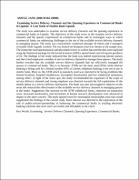| dc.description.abstract | AMUGE JANE (2008-M102-20008)
Examining Service Delivery Channels and the Queuing Experience in Commercial Banks in Uganda: A Case Study of Stanbic Bank Uganda
The study was undertaken to examine service delivery channels and the queuing experience in commercial banks in Uganda. The objectives of the study were; to the examine service delivery channels and the queues experienced in commercial banks and to investigate ways in which commercial banks are addressing challenges to the use of the available service delivery channels in managing queues. The study was conveniently conducted amongst 50 clients and 2 managers of stanbic bank Uganda Limited. The city branch on Kampala road was chosen as the sample area. The researcher used questionnaires and document review to collect data and the data were analysed using the Statistical package for the Social Sciences (SSPS), spread sheets and chi square goodness of fit. The findings of the study indicated that the bank was indeed experiencing intense queues and that it had employed a number of service delivery channels to manage these queues. The study further revealed that the available service delivery channels had not effectively managed the queues in commercial banks. This is so because, ATMs are the most used (95%) while internet banking is being used by a limited number (8%) of clients; telephone banking is not yet in use in stanbic bank. More so, the ATM which is popularly used was reported to be facing problems like limited locations, frequent breakdowns, incomplete functionality and low withdrawal minimums among others. In light of the status quo, the study recommended the expansion of the scope of service delivery channels and strong emphasis was directed towards the full exploitation of the mobile phone as a service delivery mechanism. The bank was also encouraged to improve on the areas that reduced the effectiveness of the available service delivery channels in managing queues in the banks. Suggestions like increase on the ATM withdrawal limits, reduction on transaction costs, increased sensitisation, and investment in human resource development were advanced in respect to the latter concern. The study opened room for meaningful researchable areas that would supplement the findings of the current study. Keen interest was directed to the exploration of the role of public-private-partnerships in bolstering the commercial banks in availing electronic banking solutions that were more accessible and affordable to the client.
Key Words: Examining, Service Delivery Channels, Queuing Experience, Commercial Banks. | en_US |


